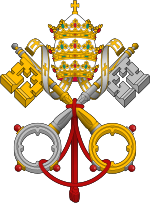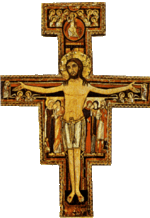Pope Sixtus III
| Pope Sixtus III | |
|---|---|
 |
|
| Papacy began | July 31 432 |
| Papacy ended | August 18 440 |
| Predecessor | Celestine I |
| Successor | Leo I |
| Personal details | |
| Birth name | ??? |
| Born | not known |
| Died | August 6, 440 Rome, Western Roman Empire |
| Papal styles of Pope Sixtus III |
|
|---|---|
 |
|
| Reference style | His Holiness |
| Spoken style | Your Holiness |
| Religious style | Holy Father |
| Posthumous style | Saint |
Pope Saint Sixtus III was pope from July 31 432 to August 18 440.
The name of Sixtus is often connected with a great building boom in Rome: Santa Sabina on the Aventine Hill was dedicated during his pontificate and he built Santa Maria Maggiore, whose dedication to Mary the Mother of God reflected his acceptance of the Ecumenical council of Ephesus which closed in 431. At that council the debate over Christ's human and divine natures turned on whether Mary could legitimately be called the "Mother of God" or only "Mother of Christ". The council gave her the Greek title Theotokos (literally "God-bearer", or "Mother of God"), and the dedication of the large church in Rome is a response to that.
Prior to being made pope Sixtus was a patron of Pelagius, who was later condemned as a heretic.[1]
One of his main concerns was in restoring peace between Cyril of Alexandria and the Syrians.
He also maintained the rights of the pope over Illyria and the position of the archbishop of Thessalonica as head of the Illyrian church.
References
- ↑ Brown, Peter. "Pelagius and his Supporters." Journal of Theological Studies. 1968.XIX.1(93-114).
 "Pope St. Sixtus III" in the 1913 Catholic Encyclopedia.
"Pope St. Sixtus III" in the 1913 Catholic Encyclopedia.
External links
| Catholic Church titles | ||
|---|---|---|
| Preceded by Celestine I |
Pope 432–440 |
Succeeded by Leo I |
|
|||||||||||||||||||||||||||||||||||||||||||||
|
|||||||||||||||||||||||||||||||||||||||||

